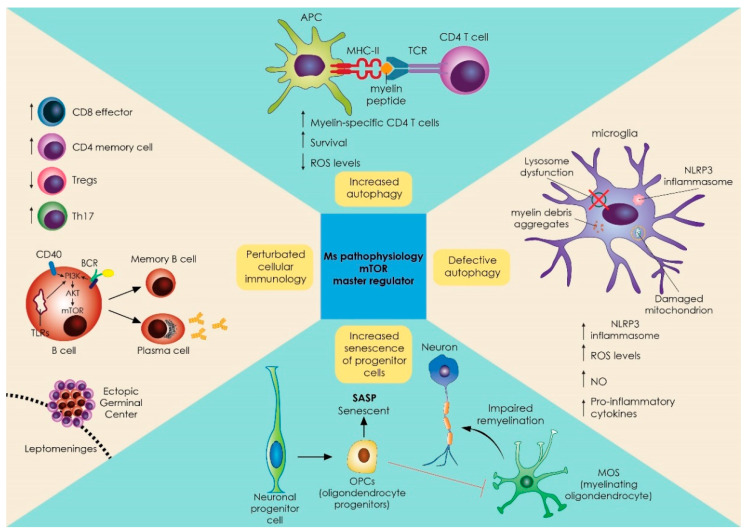Figure 2.
mTOR signaling pathway as a master regulator of many aberrant immune responses and biological processes implicated in MS pathogenesis. mTOR is critical in the development and function of various immune cells that play an important role in MS pathology. The picture shows the effects of mTOR inhibition in T cells, B cells, oligodendrocyte progenitor cells, macrophages, and microglial cells, as well as the effects of mTOR on the autophagy process that regulates the inflammatory phenotype of various cells such as neurons, microglia, and other glial cells. In the top part, increased levels of autophagy could lead to enhanced myelin processing, and antigen presentation to CD4 autoreactive T-cells in antigen presenting cells. Increased autophagy also prolongs survival of activated CD4 and CD8 T-cells. On the right, defective autophagy leads to aberrant clearance of damaged mitochondria, inflammasomes, and myelin debris in microglia, and fuels a pro-inflammatory phenotype. At the bottom of the figure, neural progenitors are affected by the presence of SASP, affecting the differentiation of OPCs and reducing remyelination of neurons. On the left, upstream regulation of BCR, CD40, and TLR signaling leads to a downstream PI3K/AKT/mTOR pathway and differentiation of B cells by T cell help, promoting the anabolic process of dark zone centroblast proliferation. AKT: protein kinase B; APC: antigen-presenting cell; BCR: B cell receptor; Th: T helper cell; PI3K: phosphoinositide 3-kinase; MHC: major histocompatibility complex; mTOR: mammalian target of rapamycin; NLRP3: nucleotide-binding oligomerization domain (NOD)-like receptor protein 3; NO: nitric oxide; ROS: reactive oxygen species; SASP: senescence-associated secretory phenotype; T reg: T-regulatory cells.

